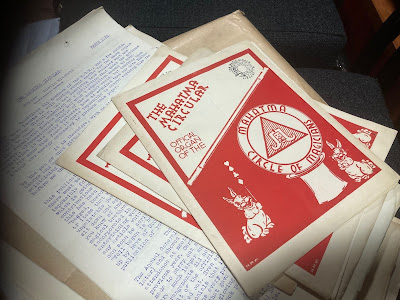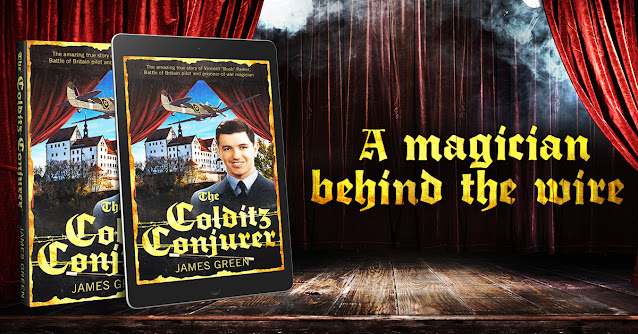Eric Ryder: Liverpool magician makes magic in a German POW camp (Part 1)
Hidden away in the magic column of a 1942 edition of The World’s Fair (a newspaper for entertainers) is this single sentence:
“From The Mahatma Circular, we learn that a member of MAHATMA CIRCLE OF MAGICIANS, Sergeant Charles Ryder, 947433, is a prisoner of war in Stalag VIII-B, Germany (P.O. War No. 9592).”
This is a tantalising fleck of information for a blog focused on magicians in World War Two. I pulled on that thread and weaved together the additional information I found into the blog below…
The Mahatma Circle of Magicians was a magic society based in Liverpool, England. Founded in 1915, in the second year of World War One, it was a breakaway club from the Northern Magical Society.
From 1915 to 1955, the society’s official in-house magazine was The Mahatma Circular. Evidently, The World’s Fair had picked up the news about Ryder in the Circular and repeated it.
Pre-War
I hoped to discover more about Charles Ryder from the society’s records, but this turned out to be a dead-end. The original headquarters of the club was The Goat Hotel, Liverpool. Unfortunately, German bombs destroyed the building in May 1941 during the Liverpool Blitz. All the society’s records, library, trophies, and other memorabilia stored at the hotel between club meetings were lost.
This led me to search for copies of The Mahatma Circular which still exist, either reacquired by the club for its own library, or held in other collections.
From these, I learned that Charles Ryder was known as ‘Eric’ (an abbreviation of his middle name, Frederick).
Census and other official records show that he was born as Charles Frederick Seymour Ryder on 2 May 1921 in the seaside town of Felixstowe, Suffolk on England’s east coast.
In 1939, 18-year-old Ryder was living with his sister and parents at 83 Menlove Avenue, a four-bedroom detached property in south-east Liverpool.
He worked as an assistant manager with Buurfing & Stor, a manufacturing factory in the city, pursuing his hobby as a magician on weekday evenings and at the weekend.
When World War Two started in September that year, Ryder signed up for the Royal Air Force’s (RAF) Volunteer Reserve.
Joining the RAF
While he started as an aircraftman on 19 January 1940, the RAF soon recognised Ryder’s middle-class educational background and managerial ability, and promoted him to the rank of Corporal and, later, Sergeant.
A non-commissioned officer, 947433 Sergeant Ryder, was trained as a wireless (radio) operator and an air gunner.
By 1941, two years into the war, was serving with No. 35 (Madras Presidency) Squadron, based at RAF Linton on Ouse in North Yorkshire.
Formed in 1916, just a year after the Mahatma Circle of Magicians started, No. 35 (Madras Presidency) Squadron began its existence as part of the British Army’s Royal Flying Corps. When the RAF was formed on 1 April 1918, they incorporated No. 35 Squadron. The squadron performed a variety of roles in the inter-war years until the RAF temporarily disbanded it, reforming it again in November 1940.
Ryder’s squadron was the first in the RAF to be equipped with the Handley Page Halifax aircraft.
A group photograph of No. 35 (Madras Presidency) Squadron RAF (possibly including ‘Eric’ Ryder) with a Handley Page Halifax heavy bomber in the background
(Source: Public domain)
The ‘Halifax’ was a four-engine heavy bomber, built by Handley Page Limited. A major component of the RAF’s Bomber Command, it was used for routine strategic bombing missions against the Aix Powers, many of them at night.
The Halifax was first used in action in March 1941, by No. 35 Squadron, on a bombing raid against the German-occupied French port at Le Havre.
The RAF kept the aircraft’s existence secret and did not officially acknowledge it existed until July 1941, after they used it in a daylight raid on La Pallice, France against the German battleship Scharnhorst. Sergeant Ryder was likely part of the aircrews who flew on this raid.

German battleship Scharnhorst
(Source: Creative Commons licence)
This was not the first time the British had tried (and failed) to destroy the Scharnhorst by air; and not the first time a magician was part of the attack. Magician-pilot John Casson became a prisoner-of-war after the Germans shot him down when he was dive-bombing the battleship in Norway on 14 June 1940.
Read more about John Casson (‘The Magician of Stalag Luft III’) here.
A close shave
A month after the Scharnhorst attack, on the night of 12 / 13 August 1941, Ryder was a crew member of Halifax L9566, tasked with undertaking an operational flight to bomb Berlin. They were supporting a Soviet bombing campaign, which started a few days earlier.
Almost six hundred miles from Linton on Ouse, Germany’s heavily defended capital city was a tough target to attack.
The aircraft took off at 21.40hrs. It made it to Berlin, but flak damaged it over Germany. Fortunately, Ryder and his crew made a safe return to base, arriving home at 04.10hrs.
Not so lucky
Halifax L9566 continued to be used by No. 35 Squadron until the night of 10 / 11 September 1941, when the aircraft was on a bombing mission to Turin, Italy. Apart from the second pilot, the seven-man crew was the same as on the earlier raid on Berlin. As before, Sergeant Ryder was the wireless operator and spare gunner.
Owing to its importance as an industrial centre, home to Fiat and several other industries engaged in war production, the city of Turin suffered over a hundred raids by the Allied air forces during the war.
The return trip to Turin was over 1,500 miles, which was near the maximum distance the Halifax could fly without refuelling.
This raid by Bomber Command was the twelfth air raid of the war on Turin. Formed from seventy-six bombers, the raid was launched from bases in England, to attack Turin and Genoa.
Five of the British bombers were shot down. Halifax L9566 survived the raid but failed to return to base. No. 35 Squadron’s Operations Record Book records:
“Task completed message was received shortly after 01.00hrs then at about 05.25hrs SOS received. Fix showed aircraft off track near St. Malo. QDMs [a magnetic course from the aircraft to the airfield] were given.
“At approximately 06.00hrs signalled ‘30 minutes petrol left’ but should have been near English Coast. ‘We are going out to sea if we follow QDMs were received from aircraft at 06.15hrs. Radio location plot placed an aircraft then at twenty-five miles north of Le Havre.
“This aircraft was not heard of again and did not return, presumably mistaking the Cherbourg peninsula for the coast of Kent and turning, actually, back to France.”
On its return flight, the Halifax’s crew made a navigation error and ended up turning back over France. They made a forced landing in Northern France, near Saint-Pierre-Eglise, near Cherbourg. Either the pilot and navigator thought they were landing in England or else they were low on fuel and forced to land.
This dreadful situation resulted in the loss of the hitherto ‘secret’ aircraft to the Germans and seven men becoming prisoners-of-war (POWs) for the rest of the war.
Missing in action
Not knowing the fate of Halifax L9566, No. 35 Squadron informed Bomber Command, the Air Ministry, and the RAF Records Office that the aircraft and crew were missing.
A telegram, along with a follow-up letter from the Commanding Officer, was sent to ‘Eric’ Ryder’s next of kin advising them he was “missing as the result of air operations on 10 / 11 September 1941.”
Ryder’s kit and belongings were removed from his room and catalogued. His military kit was returned to the stores to be issued to another airman, while his personal belongings were sent to the RAF Central Depository at RAF Colnbrook.
Unsurprisingly, given his magic hobby, the list of items among Ryder’s belongings included a healthy amount of playing cards; seven packs.
An inventory of Sergeant Ryder’s personal possessions left back in the UK after his capture in France, showing “7 packs of playing cards” likely related to his hobby as a magician
(Source: National Archives)
For four weeks, the RAF and Ryder’s family presumed he’d been killed in an aircraft crash, because of the Halifax running out of fuel or getting shot down by the Germans.
Happily, on 16 October 1941, British authorities received information from the International Red Cross Society that Ryder and his fellow crew members were alive.
But they were now prisoners of war in Germany.
Part 2 of this post is coming soon. Check back in to discover how Ryder got hold of magic props in captivity and used these to boost morale among his fellow captives.
With thanks to the Liverpool Mahatma Magic Circle (the successor society of the The Mahatma Circle of Magicians) for their assistance with the preparation of this blog post.
*** AVAILABLE NOW ***
The Colditz Conjurer tells the amazing true story of Flight Lieutenant Vincent ‘Bush’ Parker, Battle of Britain pilot and prisoner-of-war magician.
Written by the Magic at War team, The Colditz Conjurer is a remarkable tale of perseverance, courage and cunning in the face of adversity. It features over 55 original photographs and maps. 126 pages.













Comments
Post a Comment